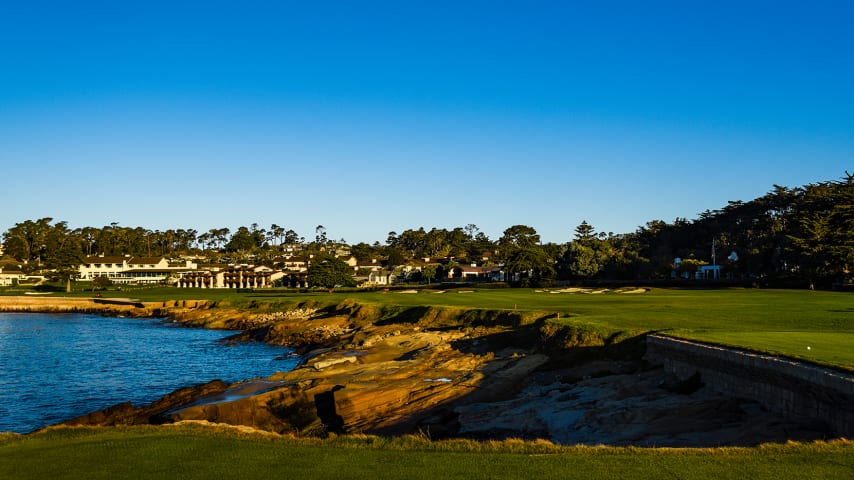Five things to know: Pebble Beach Golf Links
7 Min Read

Written by Sean Martin
The PGA TOUR visits picturesque Pebble Beach this week for one of its most historic events, the AT&T Pebble Beach Pro-Am. The 2024 iteration features a reimagined format as a Signature Event with 80 professionals and no cut.
Professionals and their amateur partners will play the first two rounds across Pebble Beach Golf Links and Spyglass Hill Golf Course; the third and fourth rounds will be played at Pebble Beach Golf Links, featuring only professionals.
Robert Louis Stevenson is credited with calling Pebble Beach “the most felicitous meeting of land and sea.” Jack Nicklaus picked Pebble Beach as his preferred site if he had just one last round to play. Fortunately for PGA TOUR players, they can return to Pebble Beach on an annual basis.
Before this year’s AT&T Pebble Beach Pro-Am, here are Five Things to Know about the history of one of America’s most iconic courses.
1. AS NATURE INTENDED IT
It’s impossible to fathom now, but the first attempt to construct the Pebble Beach Golf Links was unsuccessful. Twenty-five memberships for the new seaside course were sold for $25 apiece, according to Neal Hotelling’s official history of Pebble Beach. Nine temporary oil-and-sand-greens were built. In April 1910, the new course was advertised as “soon to open.” Ten members backed out, though, and the plans were scrapped. It was nearly a decade before golf was played at Pebble Beach.
Then the land that is now one of the world’s most famous courses was almost sold for housing lots, but Samuel Morse destroyed the plans and convinced the owners that the land would be better used as a golf course.
Morse hired two amateur architects, Jack Neville and Douglas Grant, to design Pebble Beach.
“The big idea was to get as many holes as possible along the bay,” Neville said. “Nature had intended it to be nothing else but a golf links.”
The San Francisco Chronicle said the course was opened “somewhat prematurely.” At a time when golf balls cost more than the greens fee, the course was deemed too difficult. One newspaper called the course “a conspiracy to make necessary the purchase of large quantities of golf balls.”
“The critiques on the opening day included lack of turf, rock-infested fairways and indentations on the greens from the sheep employed to maintain the grounds,” Hotelling wrote.
Pebble Beach was closed for nearly a year until being re-opened on Washington’s Birthday in 1919. The California Golf Association did not deem the course suitable to host even the state amateur, however. Improvements were continually made over the next decade, culminating with a renovation to prepare Pebble Beach to host the 1929 U.S. Amateur, which was the first of the United States Golf Association’s major championships to be held west of the Mississippi.
2. TINY TARGETS
Its small putting surfaces are one of Pebble Beach’s defining characteristics. The greens average 3,500 square feet, making them the tiniest on TOUR.
Those greens are one reason Rich Beem, the 2002 PGA Championship winner, called Pebble Beach “one of the most intimidating golf courses I’ve ever played.”
“You get caught up in the views so easily,” he said, “and all of a sudden you’ve got all of these difficult shots into greens that look like the size of dimes.”
Pebble Beach ranked a rather pedestrian 25th in greens hit percentage last season, but it was in the top 20 of hardest greens to hit in four of the previous six seasons. Its average rank across 2018, 2019 and 2020 was 13th, despite the fact that the course setup cannot be too severe because of the amateurs competing alongside the pros.
The greens are protected by the ocean breeze, Stillwater Cove and more bunkers (117) than the Old Course at St. Andrews.
3. OCEAN VIEWS
Pebble Beach is best known for its seaside holes. That includes a trio around the turn that is among the world’s best. After an opening stretch of seven holes that offer a friendly welcome to Pebble Beach, players confront three par-4s that are as difficult as they are beautiful.
It starts with the eighth hole, which Nicklaus called the “finest second shot in golf.” Woods said it was one of the most daunting approach shots in the game.
Players hit a blind tee shot to a fairway that’s some 10 stories above the ocean. The approach shot must sail over the cliffs to a small, severely-sloped green that sits below the golfer.
Nos. 8 and 9 were the two hardest holes at Pebble Beach last year. The par-4 eighth hole, which measures 428 yards, played to a 4.23 scoring average. The 504-yard, par-4 ninth saw an average score of 4.385.
Nos. 9 and 10 – a pair of par-4s that can combine to measure 1,000 yards – both feature fairways that slope toward the ocean. A drive down the right side, near the beach, offers the best angle to both greens. Bunkers protect the left side of both putting surfaces, and the ocean isn’t far from the right side. Players must hit their approach with the ball sitting well below their feet.
The ninth fairway plateaus 200 yards from the green before falling toward Carmel Beach, leaving players a downhill lie to the green. The par-4 10th hole has the widest fairway on the course, which is one reason why, despite having a scorecard yardage of 495 yards, it played just .04 over par in 2023.
“People are starting to understand how good these holes are,” golf architect Tom Doak wrote. “That’s what you remember after playing the course the first time, not 17 and 18. If 8, 9 and 10 were the closing holes, it would be the most famous finish in golf.”
4. FIVE ON IT
Par-5s are supposed to be birdie opportunities, but that’s not the case on Pebble Beach’s back nine.
The 14th hole runs uphill, away from the water, and doglegs right. The 18th hole turns to the left as it hugs Stillwater Cove. They’re two very different holes, but both offer a challenge not normally found on three-shot holes.
The 14th green was designed by local artist Francis McComas, who also was an avid golfer. To give the long, uphill hole a unique flair, McComas created a two-tiered green settled among overhanging oaks. A large bunker protects the upper tier on the left. His creation is one of the most recognizable greens at Pebble Beach.
It also is one of the most difficult. The 14th annually ranks as one of the toughest par-5s on the PGA TOUR, having played to a 5.05 scoring average in 2021, making it one of just six par-5s to play over par that season (and one of just three that weren’t on a major-championship venue).
Pebble Beach’s famous finishing hole isn’t much easier, playing to an average score around par (4.92 in 2023). The hole wasn’t always a dramatic par-5 that dares players to flirt with Stillwater Cove, though.
It started as a 325-yard par-4 that was once deemed a “woefully poor finishing hole.” To add some intrigue to the 18th hole, a new tee was built on the rocks behind the 17th green. It added 35 yards to the hole and forced players to carry the cove.
The hole finally became a par-5 in 1922, after a creek behind the green was culverted. This allowed the green to be moved 170 yards down the coast.
5. WINNERS LIST
Pebble Beach, of course, went on to have a storied history as a venue for the game’s biggest events. It has hosted the AT&T Pebble Beach Pro-Am since 1947, with World Golf Hall of Famers Mark O’Meara and Phil Mickelson each winning the event a record five times. Past winners of the AT&T at Pebble Beach also include Ben Hogan, Byron Nelson, Billy Casper, Ken Venturi, Johnny Miller, Tom Watson, Davis Love III, Vijay Singh, Nicklaus and Woods.
Woods, Nicklaus, Kite and Watson have won both the AT&T and a U.S. Open at Pebble Beach. Woods (2000) and Nicklaus (1972) did it in the same year. Nicklaus also won the 1961 U.S. Amateur at Pebble Beach.




